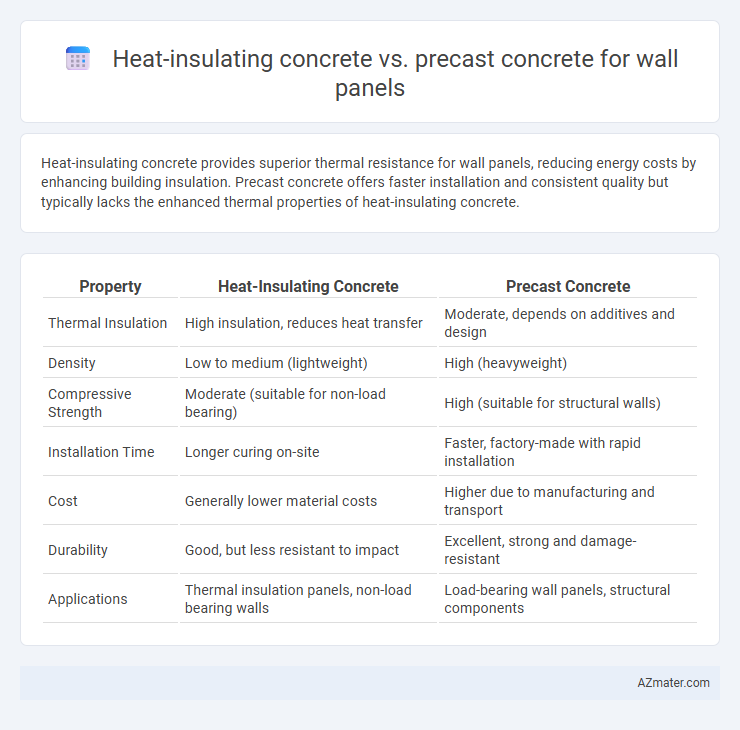Heat-insulating concrete provides superior thermal resistance for wall panels, reducing energy costs by enhancing building insulation. Precast concrete offers faster installation and consistent quality but typically lacks the enhanced thermal properties of heat-insulating concrete.
Table of Comparison
| Property | Heat-Insulating Concrete | Precast Concrete |
|---|---|---|
| Thermal Insulation | High insulation, reduces heat transfer | Moderate, depends on additives and design |
| Density | Low to medium (lightweight) | High (heavyweight) |
| Compressive Strength | Moderate (suitable for non-load bearing) | High (suitable for structural walls) |
| Installation Time | Longer curing on-site | Faster, factory-made with rapid installation |
| Cost | Generally lower material costs | Higher due to manufacturing and transport |
| Durability | Good, but less resistant to impact | Excellent, strong and damage-resistant |
| Applications | Thermal insulation panels, non-load bearing walls | Load-bearing wall panels, structural components |
Introduction: Understanding Wall Panel Materials
Heat-insulating concrete offers superior thermal resistance by incorporating lightweight aggregates and insulating additives, reducing energy consumption in buildings. Precast concrete wall panels provide high structural strength and rapid installation due to factory-controlled quality and standardized dimensions. Selecting between heat-insulating and precast concrete depends on project priorities such as thermal efficiency, construction speed, and load-bearing requirements.
What is Heat-Insulating Concrete?
Heat-insulating concrete is a specially formulated material designed to provide superior thermal resistance, reducing heat transfer through wall panels and enhancing energy efficiency in buildings. It typically incorporates insulating aggregates like expanded polystyrene beads, perlite, or vermiculite, which improve its thermal performance compared to traditional dense concrete. Precast concrete wall panels, while offering structural strength and durability, generally lack the inherent thermal insulation properties of heat-insulating concrete unless combined with additional insulation layers.
Overview of Precast Concrete Wall Panels
Precast concrete wall panels are factory-manufactured, cured, and transported to the construction site for quick installation, offering superior quality control and consistent structural performance. These panels provide excellent durability, enhanced fire resistance, and reduced construction time compared to traditional methods. While heat-insulating concrete includes integrated thermal properties, precast panels can be engineered with embedded insulation layers to optimize energy efficiency in building envelopes.
Thermal Performance Comparison
Heat-insulating concrete offers superior thermal resistance due to integrated insulating materials like expanded polystyrene or mineral wool, significantly reducing heat transfer through wall panels. Precast concrete panels typically provide high structural strength but have lower inherent thermal insulation properties, often requiring additional insulation layers to meet energy efficiency standards. Overall, heat-insulating concrete achieves better energy savings and indoor temperature regulation compared to conventional precast concrete in wall panel applications.
Structural Strength and Durability
Heat-insulating concrete panels offer enhanced thermal resistance while maintaining high compressive strength, making them ideal for energy-efficient building envelopes. Precast concrete wall panels provide superior structural durability due to factory-controlled conditions that ensure consistent quality, higher density, and resistance to environmental stressors. Comparing both, heat-insulating concrete excels in thermal performance without significantly compromising strength, whereas precast concrete prioritizes long-term durability and load-bearing capacity.
Installation Speed and Construction Methods
Heat-insulating concrete panels offer faster installation due to their lightweight properties and integrated thermal resistance, reducing the need for additional insulation layers on-site. Precast concrete wall panels typically require crane lifts and precise placement, which can extend installation time but ensure consistent quality and structural integrity. Streamlined construction methods with heat-insulating concrete panels minimize labor and equipment demands, accelerating overall project timelines in comparison to traditional precast panel installation processes.
Energy Efficiency and Sustainability
Heat-insulating concrete wall panels significantly enhance energy efficiency by providing superior thermal resistance, reducing heating and cooling costs in buildings. Precast concrete panels offer sustainability benefits through factory-controlled production, minimizing waste and allowing recycled materials integration, but typically lack the advanced insulation properties of specialized heat-insulating mixes. Combining precast technology with heat-insulating concrete formulations can optimize both energy performance and sustainable building practices.
Cost Analysis: Initial Investment and Lifecycle
Heat-insulating concrete wall panels typically have higher initial investment costs due to specialized materials like aerogels or integrated insulation layers, increasing production expenses compared to standard precast concrete panels. Lifecycle cost analysis shows that heat-insulating concrete reduces energy consumption and maintenance expenses by enhancing thermal performance, leading to long-term savings that offset initial costs. Precast concrete panels offer lower upfront costs but may incur higher operational energy costs and maintenance, making heat-insulating concrete a more cost-effective choice over the building's lifespan in energy-efficient construction.
Design Flexibility and Aesthetic Options
Heat-insulating concrete offers superior design flexibility through its ability to integrate customized thermal properties, allowing architects to optimize energy efficiency without sacrificing structural integrity. Precast concrete wall panels excel in aesthetic options by providing a wide range of surface finishes, textures, and shapes achieved through controlled factory production, enabling consistent quality and precise detailing. While heat-insulating concrete supports innovative thermal designs, precast concrete panels deliver enhanced visual variety and rapid installation, making each material uniquely suitable for specific architectural goals.
Conclusion: Choosing the Best Wall Panel Solution
Heat-insulating concrete wall panels provide superior thermal efficiency by combining insulation materials within the concrete matrix, reducing energy consumption and enhancing indoor comfort. Precast concrete panels offer faster installation, high structural strength, and consistent quality due to factory-controlled manufacturing processes. Selecting the best wall panel solution depends on project priorities such as energy performance, installation speed, and budget constraints, with heat-insulating panels excelling in sustainability and precast panels excelling in construction efficiency.

Infographic: Heat-insulating concrete vs Precast concrete for Wall panel
 azmater.com
azmater.com